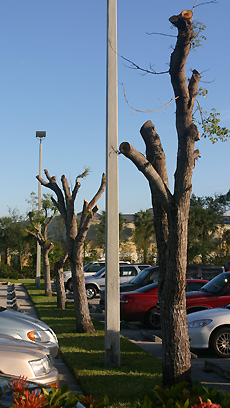Home > Pruning shade trees > Reducing the canopy > Do not top trees
Do not top trees

Topping trees: do we really need to go there?
Dr. Ed Gilman, professor, University of Florida
Recent hurricanes have created demand from some of the public for topping shade trees. Allowing urban trees to be topped is misguided and would set back arboriculture in Florida 30 years!
I can not even imagine turning back the clock to the days when we taught that topping was inappropriate and short sighted. I have not given that lecture in more than 10 years! Our combined educational efforts are advancing tree care in Florida to the point where some look to Florida as a model for the country. But I can feel the earth vibrating from the discussions that consider topping as appropriate for trees in the "hurricane belt." We might have to dust off our presentations that teach the myriad of reasons why topping is so bad for people and trees.
I have heard the comment that "recently topped trees were still standing following the storm so this must be a good way to manage trees". Of course recently topped trees will not be affected by strong winds because there is no canopy to catch the wind. However, as you know the issue is not that simple.
Consider this. The disadvantages of topping include hotter urban environments (urban heat island effect), increased storm water volume and flooding, increased run-off into wetlands, more leaching of nutrients and pesticides into groundwater, less shade, more CO2 in the atmosphere (contributing to global warming), less attractive urban landscapes, less wildlife habitat, less sign visibility, increased energy costs for air-conditioning, and in some cases dead trees. These documented costs are huge! Also, we know that many topped trees decay in the cut branches and trunks and in the long run they can break apart more easily than trees appropriately pruned. Topping also generates large volumes of brush requiring chipping or landfilling. Since topping keeps trees small there is less shade in parking lots resulting in more volatilization of gasoline from gas tanks. In addition, asphalt in the sun breaks down quicker than asphalt in the shade, requiring replacement more often. As you can see, topping is not simply a tree issue.
Now let's list the advantages of topping……………. I can't think of any!
There are proven proactive methods for reducing tree damage in storms, and restoring trees following the storm. These include appropriate reduction of the canopy or portions of the canopy, structural pruning, pollarding, appropriate landscape design, appropriate tree placement, and species selection. These and many other strategies are addressed in the Urban Forestry Hurricane Recovery Program, See: Urban Forest Hurricane Recovery Program. Unfortunately, few trees receive appropriate care and many are misplaced; this largely contributed to the problems experienced during recent hurricanes.
As an advance civilized society most communities have decided that the risks of planting large maturing shade trees is balanced by the benefits they provide. Communities might decide that in light of the recent cyclical increase of hurricane activity that planting large shade trees is not in the best interest in their community. I think this is short sighted and misguided. In light of the overwhelming benefits trees provide we must continue to stress the importance of APPROPRIATE pruning and other strategies to reduce storm damage. We know that structural pruning reduces storm damage but unfortunately few trees in our urban landscapes receive this treatment. And the reasons for this are many, chief of which may be lack of understanding and demand by consumers. We have to work on the demand side.
Remember that about 41,000 people (1999 statistics) in the US die each year
in more than 6 million car accidents! The best way to avoid being killed in
a car accident is to not drive. Most people decide that this is impractical.
Is cutting down our urban forest to stubs practical and in good public interest?
I don't think so.

